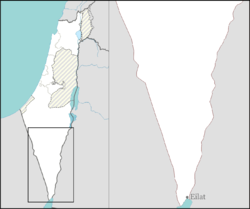Ir Ovot
Ir Ovot
עִיר אֹבֹת | |
|---|---|
Oboth | |
| Coordinates: 30°48′32″N 35°14′45″E / 30.80889°N 35.24583°E | |
| Country | |
| District | Southern |
| Council | Central Arava |
| Founded | 1967 |
| Population (2019)[1] | 54 |
Ir Ovot (
It is the site of an extensive archaeological complex known as Tamar Fortress or Hatzevah Fortress (
Geography
Ir Ovot is located south of the Dead Sea and southeast of Dimona in the Arabah valley, an arid plain located below the Negev plateau and south of the Jordan Rift Valley within the larger Great Rift Valley. The settlement abuts the Ein Hatzeva bloc of agricultural villages on the opposite side of Highway 90 near the Jordanian border, and is within the boundaries of the Tamar Regional Council.[citation needed] The community is located close to the biblical site of Tamar, and is west of Hatzeva Junction. [2]
History
Originally the site of the Ein Husub police station during the British Mandate of Palestine, the location was captured by the Israel Defense Forces in 1948. The village of Ir Ovot was founded in 1967, in an area deserted apart from a small military base and roadside cafe on the way to Eilat.
In 2018 Ir Ovot had 250 housing units were approved. [3]
History of the Hatzeva Fortress


First observed and documented by
The first salvage
The area was used for training crews in site conservation before their work on the Masada site.[6]
10th century BCE
The earliest remains, dating to the
9th–8th century BCE
The second layer consists of a very large
Excavation revealed a four-chambered, north-facing gate complex near the northeastern corner and three storerooms, a pair of
7th–6th century BCE
A third fortress from the Late First Temple period from the 7th–6th centuries BCE was found, though because only the walls' foundations remain, reconstructing the floor plan has been difficult. However, an eastern wall with two towers set 14 metres (46 ft) apart was reconstructed.[5]
A pit full of smashed clay and stone, which were reassembled into 74
1st–4th century CE
Evidence of Roman administrative and military presence is plentiful, and the junction of the east–west
The Roman fortress' layout is similar to other imperial outposts in the region. An official Latin inscription that dates several area strongholds to the 3rd century CE was discovered on a large limestone slab at nearby Yotvata bears. This site was the largest in the area at 46 square metres (495 sq ft), and included four projecting towers on the fortress' corners. Artefacts tell of probably destruction in the middle of the fourth century CE, perhaps by a 344 earthquake, though it was promptly rebuilt with improved, stone flooring and again destroyed two decades later, probably from an earthquake in 363.[5]
A
7th–8th century CE
A building fragment
References
- ^ a b "Population in the Localities 2019" (XLS). Israel Central Bureau of Statistics. Retrieved 16 August 2020.
- ^ "Two new Negev towns approved". Globes. 8 July 2018.
- ^ "Two new Negev towns approved". Globes. 8 July 2018.
- Blossoming Rose. Archived from the originalon 2007-05-18.
- ^ a b c d e f g h i j k Matt VandeBunte (March 2004). "Excavation at Biblical Tamar Park". The Boble and Interpretation. Archived from the original on 2004-03-27. Retrieved 2007-09-24.
- ^ "Conservation projects by region". Archaeology Conservation Center. Archived from the original on 2007-09-28. Retrieved 2007-09-24.
External links
- Exploring ancient Israelite fortress: Biblical Tamar - Ir Ovot Exploring ancient Israelite fortress: Biblical Tamar - Ir Ovot
- Arava.com (in Hebrew)
See also
- Biblical archaeology
- Incense Route - Desert Cities in the Negev
- Iudaea Province
- History of ancient Israel and Judah


